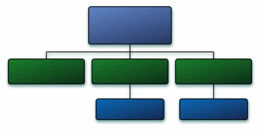Designing Your Site's Information Architecture

Information architecture is a big topic. However you are building sites, it's essential to think deeply and clearly about how best to organize a site's content. If the site is a simple brochure site, there may not be much to think about, but the more content a site has, the more important it is to invest effort in this area.
If you're a graphic designer, it's natural to think in terms of pages and layouts. And indeed, that is how your site designs ultimately are delivered. But for sites with more than a little content, you'll have a lot more power if you think of the site as containing a body of information that exists independently of the pages themselves, and that can be presented in various ways. This is the essence of a database-driven site.
Databases may seem like a scary concept, and something that you'd have to hire a programmer to create. But with a tool like Webvanta, you—or whoever is coding your site—can create databases easily.
Let's look at a specific example of how this can affect the design of a site. Suppose you are building a site about recycling. You might want a page about glass, another about plastic, and another about paper. For each of those pages, you'd have some photos, some general information, related companies, and lists of resource links.

If you're not thinking in terms of a database, you'd approach each of those pages as a unique design. But in a database-driven site, glass, plastic, and paper would each be categories. For each category, you'd have a main image, additional images, a description, a list of companies, and a set of links.
With this approach, you only have to design one category page. For the site owner, adding more categories, or more information about any category, is just a matter of adding more information to the database.
When you add a company or a resource link to the database, you'd just indicate which categories it should be associated with. It would then appear automatically on those category pages. You can also have multiple sets of categories; for example, if the recycling information varies from one geographic region to another, then you could assign items to both a material type category and to a region category, and then the site could automatically have separate pages not only for each material type but also for each region.
This approach makes the site easier to maintain, and it reduces the number of pages you need to design, but it does put some additional constraints on you. Each category page should follow the same structure, and the content areas need to be able to adapt to varying amounts of content. You can't hand-tune the design of each page to the degree you might be accustomed to. But the payoff is great: fewer pages for you to design, and a site that is much easier for the site owner to maintain. In addition, you can now provide the information in the database via an RSS feed, or create different pages with some of the same information, such as for a mobile version of the site.
For a large site, designing an optimal information architecture can be a big task. But for most small and midsize business sites, it is straightforward once you get accustomed to thinking this way.
Start by identifying all of the different types of information:
- If you have pages on different topics, what kinds of things are listed on those pages? Probably links to other sites, and maybe events, books, research papers, companies, and so forth. These are your database item types.
- Look for anything where there's a repeating structure. For example, in a page that lists staff members, each may have a photo, a name, a title, a bio, a blog link, and a twitter name. That's a repeating structure, and if this is set up as an item type in the database, new staff members can be added just by filling out a form.
Then consider all of the ways you want to organize the information. For example:
- In the recycling site example above, you'd want categories for glass, plastic, and paper.
- If your information is differs by geography, then you'd want a category for each geographic region.
- If you have an organization that has board members, executives, and advisors, you'd create categories for each of them, so you can use a single "person" item type and still have a separate page for each type of person.
It takes more work up-front to do this sort of organizing, but it pays off handsomely in how effective the site is for visitors and how easy it is to build and maintain.
For more information:
- Build Your Site Around Information, Not Pages
- Introduction to Information Architecture resources from the Information Architecture Institute
- Rosenfeld Media publishes a number of great books on user experience and information architecture, and also offers webinars on related topics.
- WebMonkey Information Architecture Tutorial
- A collection of resources from Jesse James Garrett of Adaptive Path
